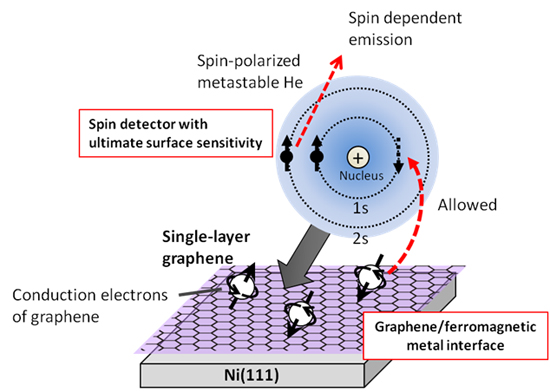Jul 5 2013
Using a spin-polarized metastable helium beam, a research group of the Japan Atomic Energy Agency (JAEA) and the National Institute for Materials Science (NIMS) succeeded in detecting the electronic spin state of only the graphene contacted to a magnetic metal in devices.
 Schematic diagram of the experimental method. When a low velocity spin-polarized metastable He beam is irradiated on the specimen surface, the He atoms rebound above the surface without penetrating to the interior. As a result, it is possible to selectively detect surface information. During the collision, the 1s-hole (black broken line arrow) is filled by a surface electron and the He atom returns to its ground state by releasing the 2s electron. Since the surface electron filing the 1s-hole should have the same spin to the hole, the ejected electron carries the spin information of surface electrons. By aligning the spin direction of 1s-hole a metastable He becomes a spin detector. In the present study the spin state of topmost layer of graphene/Ni(111), namely graphene, has been selectively detected with this method.
Schematic diagram of the experimental method. When a low velocity spin-polarized metastable He beam is irradiated on the specimen surface, the He atoms rebound above the surface without penetrating to the interior. As a result, it is possible to selectively detect surface information. During the collision, the 1s-hole (black broken line arrow) is filled by a surface electron and the He atom returns to its ground state by releasing the 2s electron. Since the surface electron filing the 1s-hole should have the same spin to the hole, the ejected electron carries the spin information of surface electrons. By aligning the spin direction of 1s-hole a metastable He becomes a spin detector. In the present study the spin state of topmost layer of graphene/Ni(111), namely graphene, has been selectively detected with this method.
Using a spin-polarized metastable helium beam, a group headed by Dr. Shiro Entani, who is a limited-term researcher at the Advanced Science Research Center, Japan Atomic Energy Agency (President: Shojiro Matsuura) and Dr. Yasushi Yamauchi, a Group Leader in the Nano Characterization Unit, National Institute for Materials Science (President: Sukekatsu Ushioda) succeeded in detecting the electronic spin state of only the graphene contacted to a magnetic metal in devices.
Graphene is considered a promising substrate material for next-generation spintronics, as it possesses many properties that are suitable for transmission of electronic spin information. In order to utilize graphene in spin devices, techniques for controlling its spin state are indispensable, and among these, the development of a spin injection technique using a magnetic electrode is a key issue. In developing these techniques, first, it is necessary to know the spin state of the graphene which is contacted to the magnetic metal electrode. It was difficult, however, for conventional techniques to selectively obtain the spin information of the graphene because the weak signal from the graphene, which comprises a single atomic layer, is buried in the strong signal from the magnetic substrate.
In this study, the JAEA-NIMS research group succeeded for the first time in observing the electronic spin state of only the graphene by measuring a junction of graphene and magnetic metal (nickel) with a spin-polarized metastable helium (He) beam. The results revealed that, in conduction electrons of graphene contacted to nickel, spin polarization occurs with the same orientation as the spin of the nickel.
This research achievement is expected to greatly advance research on the spin properties of various 2-dimensional materials including graphene which are a focus of attention as new spintronics materials, as well as device applications such as development of spin injection techniques, etc.
These results were published in the online edition of the scientific journal "CARBON."